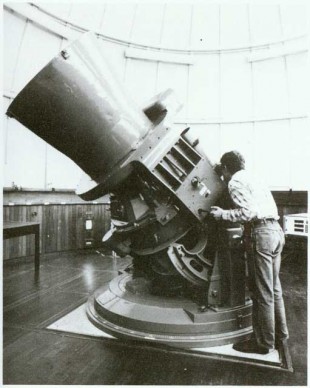…where east meets west
- Home
- Brief History
- The Greenwich Meridian
- Greenwich
(1675–1958) - Herstmonceux
(1948–1990) - Cambridge
(1990–1998) - Outstations (1822–1971)…
- – Chingford (1822–1924)
- – Deal
(1864–1927) - – Abinger
(1923–1957) - – Bristol & Bradford on Avon
(1939–1948) - – Bath
(1939–1949) - – Hartland
(1955–1967) - – Cape of Good Hope
(1959–1971)
- Administration…
- – Funding
- – Governance
- – Inventories
- – Pay
- – Regulations
- – Royal Warrants
- Contemporary Accounts
- People
- Publications
- Science
- Technology
- Telescopes
- Chronometers
- Clocks & Time
- Board of Longitude
- Libraries & Archives
- Visit
- Search
Telescope: 34-inch Hewitt Camera (1962)

The Hewitt Camera in use at Herstmonceux in the early 1980s. From Royal Greenwich Observatory, Telescopes Instruments Research and Services October 1 1980 - September 30 1985 (SERC)
Early history
Following the cancellation of Blue Streak in 1960, it was decided to use the Hewitt design to track satellites for geodetic analysis. Built by Grubb Parsons, under contract to RRE, they became operational in 1962. One was sited at Sheriff’s Lench near Evesham, Worcestershire (this became known as the ‘Malvern’ camera) and the other in Lye Vallets, Herefordshire.
From 1967 onwards, the cameras were used at Sheriff’s Lench and Edinburgh by the Ordnance Survey for geodetic triangulation using satellites. The cameras were transferred to the Earth Satellite Research Unit (ESRU) of the University of Aston in 1978 for geophysical research. Positions of satellites were measured with an accuracy of 1 to 3 arc secs and were used to determine the changes of the orbital elements of selected satellites and hence the irregularities in the gravity field of the Earth and the variations in the density of the upper atmosphere.
The move to Herstmonceux
When in 1982, it became necessary to close the Sheriff’s Lench site because of leasing and safety problems, it was decided to move the Malvern camera to join the satellite laser ranger at Herstmonceux rather than move it to a new site elsewhere. The move had the advantage of allowing expertise to be more easily shared. At around the same time, the second camera, which had been mothballed since 1975, was moved to the Anglo-Austrailian Observatory at Siding Spring, Australia, and began operating again in 1980 (or 1982?). The two cameras remained in use until the closure of the Herstmonceux site in 1990.
ESRU provided a prediction service for the cameras and for amateur observers who made visual observations in support of the orbit analysis work carried out by ESRU and other groups. Financial support for the cameras was provided by the Department of Trade and Industry and by the Ministry of Defence, as well as by SERC and NERC.
At Herstmonceux, observations were often carried out on behalf of outside organisations, for example, the observation of geostationary objects for the Department of Trade and Industry. The re-entry of the Cosmos 1402 nuclear reactor in January 1983 gave much publicity to the tracking capabilities of the camera.
Technical details
The optics of the instrument is that of the ‘Schmidt Camera’, combining good light-gathering power with a wide field of view. The spherical focusing mirror has a diameter of 34 inches and a focal length of 26.77 inches. The correcting plate is 1062 mm from the front surface of the mirror, at or near its centre of curvature. The diameter of the correcting plate was 630 mm. A field flattening lens with a diameter of 16 mm sits over the photographic plate. It was used to obviate the need to bend the photographic plate to the curved focal plane of the classical Schmidt design. The system was arranged to produce a circular focal plane diameter of approximately 100 mm on the photographic plate, and this gave a field of 10 degrees.
History following the closure of the Herstmonceux site in 1990
At the time of the closure of the Herstmonceux site in 1990, the archive of about 11,000 plates made with the Cameras in the UK and Australia was transferred into the keeping of Crayford Manor House Astronomical Society (see below), the camera at Herstmonceux remaining in situ. Since 1995, the camera has been in the care of the Observatory Science Centre. Dome C is not routinely opened to the public, so those wishing to see it should contact the Science Centre.
Further reading
The Hewitt Camera Archive at Crayford. J.J. Howarth. Journal of the British Astronomical Association, vol.102, no.6, p.343–350 (1992)
Royal Greenwich Observatory, Telescopes Instruments Research and Services October 1 1980 – September 30 1985 (SERC)
© 2014 – 2025 Graham Dolan
Except where indicated, all text and images are the copyright of Graham Dolan